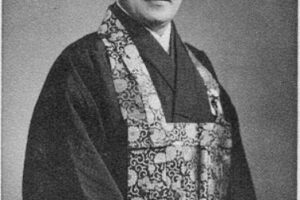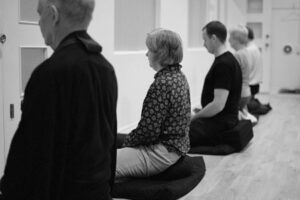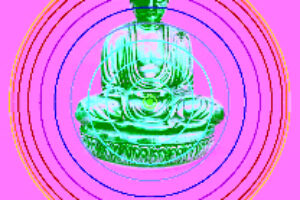
This month’s one-day retreat (J. zazenkai) was held Saturday the 20th from 9 to 3 as usual; please watch for these each month and plan to attend. The subject was “Beginner’s Mind — the Zen Approach to Working with Mind.” We also recognized Father’s Day in passing, but did not dwell upon it, and we touched upon the depressing news of the day, which gets ample coverage in the media. It certainly raises the question of the Zen mind, and how we can maintain sanity and calm in the face of insanity and chaos all around us.
As a simple answer to the challenge we often hear, questioning whether Zen Buddhists just passively accept the horrors of the world in their nondualistic, absolutist worldview, I tried to make the point that Buddhism is not passive but active, and that meditation is the most we can do, as Matsuoka Roshi often pointed out, to engage reality. So the resolution is actually that proposed by the founder, Shakyamuni Buddha, and the Ancestors of the lineage. Those people around the world who are committing atrocities are primarily proponents of world views that are diametrically opposed to that of Zen. The central problem is the reification of the self and its belief systems, and the logical extension of enforcing them on others in the world. This is, of course, in the misguided belief that they will bring about the kind of world that their religion or philosophy envisions as ideal.
Zen, instead, suggests that the real revolution is individual and internal, not societal and external, to be imposed from the top down on a resistant population. The approach of Buddhism is to attract each individual to examine their own ignorance and opinions, to question the very basis of their presumptions, and to find the truth, without dependence upon beliefs or even the thinking mind. Which brings me to my father, who did not have the benefit of training in Zen, but who struggled his whole life with the same dilemma as Buddha, the needless suffering of the world, mostly inflicted by people upon other beings.
My father was born in 1916, and married my mother, who was born in 1913. I didn’t find this odd until I had grown to understand that usually, men tend to marry younger, not older, women. And more on the order of a decade, or several, rather than a mere three years difference.
My mother finished high school, but did not go on to higher education in any formal sense. But my father was a high school dropout, which was more common in those days, bearing less of a stigma than today. But for my dad, his lack of a formal education became a major piece of the “something missing” in his life, a gaping hole that he never managed to fill.
Which is why he insisted that his children work hard at making good grades and go to college. Consequently, I became a “straight-A” student, and paid my way through university on scholarships and loans. With three other siblings, my parents were in no position to help me out financially.
Although he was one of the most educated men I ever met, including leading his own jazz quintet on keyboards and vibes, serving as secretary of the Musicians Union Local Chapter, and becoming deeply involved in unions as a pipefitter and welder — and deeply disappointed when the union leadership turned out to be as corrupt as the companies they were supposed to defend their members against — dad never got over the frustration that he would never have a real education.
And because he was a very dominant force in our family, mostly for the better, I tended to listen closely to everything he said. From his arguments with his step-father, my “Grandpa George”, I became acquainted with the dismal art of politics, and its disappointing tendency toward corruption, just like the originally well-intended unions. He was once surprised, caught off guard, and mollified by my sudden and sincere exclamation that he should be president of the USA.
From time to time, my dad would become caught up in contemplation of the sordid state of human behavior, when a far-away look would come over him, and he would say, in a soft voice, “If they would just stop to realize…” He never finished the statement, but instead would drift off into silence, staring into space or into my returning gaze. It was as if he alone realized the futility, stupidity, insanity, of human follies, of whatever judgment he was passing on his fellow travelers. He would sometimes say that the human race is the greatest scourge on the earth, or some such term – and would quickly and self-effacingly add that that statement included himself.
So I had to wonder, as a young boy, about what I should be realizing, a lot. The term is used colloquially to indicate some sort of accomplishment, as in realizing a work of art, be it musical, painting, poetry or dance; and to come to understand something, such as coming to the realization that what we have been doing heretofore is no longer working, or never was. This latter can be true of our complicated relationships at home or at work, leading to changing jobs or getting divorced; or more simply, that the approach we have been taking is not going to achieve the results we desire. This latter is famously caricatured as one definition of insanity — doing the same thing again and again, expecting different results.
This kind of ordinary realization comes about in our Zen practice from time to time as well, when we realize that our approach to meditation, or the way we are doing dharma study, or relating to the Zen center community, is causing problems. Zen meditation, zazen, often leads to a kind of clarity where we have a “eureka” or “aha” moment (or “duh — there I go again”), wherein we can clearly see what habit or pattern of behavior is not furthering, to use the Taoist term, to our intentions. But in Zen, I think realization indicates something else entirely.
Realization is a term frequently used — some might say abused — in the literature of Buddhism and Zen. It can send the unfortunate, if unintended, message that the speaker or writer has experienced something that the reader or listener has not, fostering an us-and-them bifurcation in the community, or simply implying some superior-inferior understanding vis-à-vis the individuals in the dialog.
Not that experience doesn’t count, or that all opinions are equal in Zen praxis. It may be one of the few areas remaining in Western culture where seniority still means something positive, rather than an automatic, perceived negative, in a youth-worshiping society. But if someone has genuine realization, they would not be likely to make a big deal of it. It seems to be a humbling experience.
My favorite passage regarding realization in the Buddhist sense comes about midway through Master Dogen’s “Self-fulfilling Samadhi (J. Jijuyu Zammai)”, an excerpt from his famous tract “Bendowa” from the Shobogenzo. We chant this in the Saturday morning service, and as a side note, the fact that we Westerners tend to pronounce our multi-syllabic words in two ways — either pronouncing every syllable, or in a condensed version replacing one or more syllables with an apostrophe: re-a-li-za-tion versus rea-li-za-tion — makes for confusion, and a disjunction in the smooth flow of the chant. One person may be doing five syllables while others are doing four. And don’t get me started on the different pronunciations of “neither” in the Heart Sutra. Couldn’t the translators have avoided this variable word altogether and still retained the meaning?
All of which brings us to the realization that anomalies the translation of the teachings from languages of origin to the more linear English, and consequent issues in performing them as chants, are just not very important. It is what it is, as we like to say about things that make us throw up our hands, or just throw up.
Back to Master Dogen, including the stanza leading into the central teaching on realization, offered for your consideration (translation from Soto Shu consensus):
From the first time you meet a master, without engaging in incense offering, bowing, chanting Buddha’s name, repentance or reading scriptures, you should just wholeheartedly sit, and thus drop away body and mind. When even for a moment you express the Buddha’s seal in the three actions by sitting upright in Samadhi, the whole phenomenal world becomes the Buddha’s seal, and the entire sky turns into enlightenment.
(As a side note, it is instructive that the word processor automatically capitalized Buddha and Samadhi in the passage above, suggesting that even Western culture intuitively recognizes the special implications of such terms — which would include realization —in the context of Buddhism.)
Several stanzas then extol the implications and consequences of this seminal moment, both cosmic and local, including the effect you will have on those with whom you come in contact:
Because of this all those who live with you and speak with you will obtain endless buddha-virtue, and will unroll widely, inside and outside of the entire universe, the endless, unremitting, unthinkable, unnameable buddhadharma.
(Incidentally, in this breathless passage, I ignored the processor’s suggestion that buddha should be capitalized, because the term refers to the innate original nature, rather than to the historical figure, which may be a distinction lost upon most of our Western fellow-travelers.)
And finally to the meat of the matter, what Master Dogen has to say about the meaning of realization itself:
All this, however, does not appear within perception, because it is unconstructedness in stillness; it is immediate realization. If practice and realization were two things, as it appears to the ordinary person, each could be recognized separately. But what can be met with recognition is not realization itself, because realization is not reached by a deluded mind.
(As a last, revelatory aside, the processor redlines unconstructedness as not an acceptable construction; the translator’s choice indicates that there is no equivalent for the original term being rendered into English.)
So here the great Master is helping us to understand that this kind of realization is too immediate, in space and time, for there to be any recognition possible. That, in fact, anything recognizable, that is perceivable, can not be it; and is in fact a form of delusion, by definition. This indicates that all ordinary perception is, to some degree, delusory. And that this so-called realization is not a perception.
Here, the model of the five Skandhas, or aggregates of clinging, may be useful in grasping Master Dogen’s point, in lieu of direct experience of it. We may take the five aggregates to represent stages of progress, or insight, in our meditation. The term insight here would then have to be regarded as having the same two sides or dimensions of meaning as realization — conventional or Buddhist, or relative and absolute, if you will. We can have ordinary insight into the process or zazen, leading to extraordinary insight as an effect of zazen, amongst other influences.
Thus we may think of form, sensation, perception, impulse and consciousness — the least esoteric translation of rupa, vedana, samjna, samskara, and vijnana — as a kind of experiential spectrum, through which we move in our zazen. Beginning in the material world of form, we gradually enter into a more energetic zone of sensation; then as we adapt (e.g. become numb), moving beyond sensation into off-sensation, as John Daido Loori describes it; then into the more subtle realm of impulse — why we are doing what we’re doing in the first place, where all our reasons fall away, as Master Dogen promises will happen with body-mind; and, finally, into undifferentiated consciousness, excluding any conscious awareness of form, sensation, perception, or impulse at this juncture.
At this point, you may legitimately raise the catch-all question, “So what?” Or, as Master Dogen was challenged by an old monk in China, “What’s the use of that?”
Is this the final realization that Zen Buddhism points to? Just a blank mind? To look beyond our limited, a priori interpretation, we continue with Master Dogen:
In stillness, mind and object merge in realization, and go beyond enlightenment.
So this kind of realization involves a merging of that which is ordinarily perceived as separate; this kind of stillness is not ordinary stillness, but is characterized by nonduality, in which stillness is in the motion, perceived motion is in the stillness (J. mokurai); and thus, this “experience” is necessarily beyond enlightenment, as the achievement of enlightenment would imply a difference from the present reality, when there is no difference possible stemming from this event.
Setting aside the fact that reality is another loaded term we bandy about as if we know what it is, hopefully Master Dogen’s eloquent testimony to something into which he has obviously had direct insight, of the Buddhist variety, will encourage us to continue in our endeavors. According to this teaching, if you just simply sit still enough, for long enough, you will enter into this deep, transcendental stillness in which your mind and its objects will merge, on the road to nonduality.
This mind, the original Mind, is the beginner’s mind (J. shoshin). It is the mind we already have, with which we began this life, and the one with which it will end. Some would like to believe that this mind is eternal, that it survives death, and is reborn or goes to heaven, hopefully. Some fear that it will fall into hell. In Zen, these ideas and beliefs are all basically speculation, based on ignorance or fear.
The fundamental directive in Zen is to experience the truth of the matter for ourselves, which Zen suggests can only, or most readily, come about through meditation, by entering into that primordial stillness.
My saying this does not imply any difference in my understanding and yours. Buddhism is not something we understand; nor is understanding the reason we follow Zen, or do zazen. We just do it until it isn’t doing anything. Then it may become possible for us to understand what Master Dogen is pointing to. Please keep trying, and don’t give up too soon.








